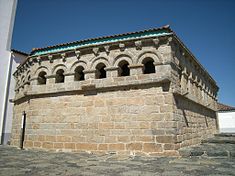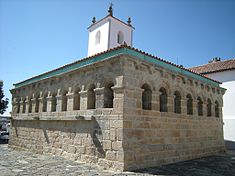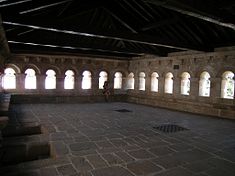- Domus Municipalis
-
Domus Municipalis (Antigos Paços Municipais de Bragança) Municipal hall (Paços Municipais) The stonework of the Domus Municipalis, located along one of the walls of the Castle of BragançaName origin: domus municipalis Latin for the municipal house Nickname: O Domus Country  Portugal
PortugalRegion Norte Subregion Alto Trás-os-Montes District Bragança Municipality Bragança Location Santa Maria - elevation 649 m (2,129 ft) - coordinates 41°48′12.81″N 6°44′55.96″W / 41.8035583°N 6.7488778°W Architects unknown Style Romanesque Materials Granite, Mortar, Wood Origin fl. 1250 - Remodelled 1503 - IPPAR Designation 23 June 1910 - Restoration 1936 - Restoration 1959 Owner Portuguese Republic For public Public Easiest access Located in the Castle of Braganza, alongside the Church of Santa Maria Management Instituto Gestão do Patrimonio Arquitectónico e Arqueológico Classification National Monument Wikimedia Commons: Domus Municipalis, Bragança Website: http://www.cm-braganca.pt/PageGen.aspx?WMCM_PaginaId=7675 The Domus municipalis (Latin: municipal house) is a Romanesque building in the northeastern municipality of Bragança in Portugal. It is what exactly was the function of this building, even after research completed in the 20th century: it could have served as cistern, but there are doubts if this was its primary function.
Contents
History
A singular (enigmatic) building of Romanesque civic architecture, it is an eloquent extension of the medieval prison tower that it juxtopositions.[1] Its construction was, most likely, in the first half of the 13th century, coincident with the foundation of the cistern.[1][2]
In 1501, in the published writings of the Abbot of Baçal, the author referred to the local record of Martim Anes, who spoke of the construction of the Domus during his life time.[2] In this account, Martin Anes stated that it was used as a meeting place for the "good men" of the municipality. By 1503, the Domus was remodelled to partition the hall into two divisions to formalize its use as municipal hall.[2]
Its designation, Domus Municipalis, actually dates back to the 19th century.[1][2]
Although the building was classified by the Instituto Português do Património Arquitectónico (IPPAR) as a National Monument in 1910, by 1912, the building was in a state of degradation, without appropriate roof and used by squatters and the poor as shelter.[2] Restoration of the building was completed in 1936 by the Direcção-Geral dos Edifícios e Monumentos Nacionais (English: General-Directorate for Buildings and National Monuments), or DGEMN (which evolved to become the Instituto de Gestão do Património Arquitectónico e Arqueológico (IGESPAR).[2] Similar restorations were undertaken in 1959 by the Serviços dos Monumentos Nacionais (English: National Monument Services), before being taken over on 1 June 1992 by the IPPAR by decree 106F/92.[2]
Architecture
Located in the Terreiro do Castelo alongside the Church of Santa Maria, the structure is based on a multi-level irregular pentagon, constructed of rounded granite blocks and held together by morter, while covered by wooden roof tiles.[2]
The Domus is constituted by two distinct spaces: the primitive cistern (documented after 1446), in order to store spring water; and a superior space that served as a gathering place for meetings of the "good men" of the community.[1] It was in the first years of the 1500s that the municipalization of Bragança, from documents dated 1503.[1]
In many of the documents, the building is referred to as the Sala da Água (English: Hall of Water).[2]
One of the shields has been identified to have been sculpted during the modern era.[2] Carlos Alberto Ferreira de Almeida noted that the other medallions, the diamond-shaped openings and the organization of windows, date the structure the beginning of the 14th century, or end of the 13th century.[2] Near one of the entrances is a bronze plaque used by the archaeologist Gomez Moreno to indicate his investigations in the structure.[2]
References
- Notes
- ^ a b c d e Câmara Municipal, ed (2009). "Domus Municipalis" (in Portuguese). Bragança, Portugal: Câmara Municipal de Bragança. http://www.cm-braganca.pt/PageGen.aspx?WMCM_PaginaId=7675. Retrieved 28 June 2011.
- ^ a b c d e f g h i j k l Paulo Amaral, ed (1996). "Paços Municipais de Bragança (antigos)/Domus Municipalis" (in Portuguese). SIPA Sistema de Informação para o Património Arquitectónico. http://www.monumentos.pt/Site/APP_PagesUser/SIPA.aspx?id=2418. Retrieved 28 June 2011.
- Sources
- DGEMN, ed. (1936) (in Portuguese), "Domus Municipalis" de Bragança, Boletim nº 4, Lisbon, Portugal: Direcção-Geral dos Edifícios e Monumentos Nacionais
- Dionísio, Santana, ed. (in Portuguese), Guia de Portugal (5 ed.), Lisbon, Portugal, pp. 949–951
- Ministério das Obras Públicas, ed. (1953) (in Portuguese), Relatório da Actividade do Ministério no ano de 1952, Lisbon, Portugal
- Ministério das Obras Públicas, ed. (1960) (in Portuguese), Relatório da Actividade do Ministério nos Anos de 1959, 1, Lisbon, Portugal
- Almeida, José António Ferreira de (1976) (in Portuguese), Tesouros Artísticos de Portugal, Lisbon, Portugal, pp. 153–154
- Almeida, Carlos Alberto Ferreira de (1986), "O românico" (in Portuguese), História da Arte em Portugal, 3, Lisbon, Portugal, pp. 141
- Gonçalves, Carla A. (1 June 2006) (in Portuguese), O lugar dos homens bons, in Mensageiro de Bragança
- Bento, Sandra (16 Dezembro 2006), "Domus Municipalis vai ser recuperada" (in Portuguese), Diário de Notícias
- IGESPAR, ed (2011). "Antigos Paços Municipais de Bragança" (in Portuguese). Lisbon, Portugal. http://www.igespar.pt/en/patrimonio/pesquisa/geral/patrimonioimovel/detail/71127/. Retrieved 28 June 2011.
External links
Categories:- Government buildings in Portugal
- Bragança
- Romanesque architecture in Portugal
- Buildings and structures completed in the 12th century
Wikimedia Foundation. 2010.



